Known as “the Natural State,” Arkansas is world-renowned for its beauty, splendor, and charm. Arkansas has many water ways from thunderous rapids cascading over the Ozark Mountains to peaceful waters swirling through the state’s lush vegetation.
The Arkansas River is the state’s most noteworthy natural beauty feature. Undoubtedly, the Arkansas River holds our attention with its beautiful lakes, rich fauna, and breathtaking vistas. It is a large tributary of the Mississippi River that generally flows east-southeastwards for 1,460 miles, traversing four U.S. states, namely Colorado, Kansas, Oklahoma, and Arkansas, before flowing into the Mississippi. Its drainage base covers 161,000 square miles, while its total fall is roughly 11,400 feet.
The river is home to different fish species, including blue catfish, spotted sunfish, sauger, crappie, bluegill, brown trout, and largemouth bass. Below, we’ll look at some of this river’s monsters — the largest fish in the Arkansas River.
But first, a few fun facts:
- The Arkansas River ranks as the sixth-longest in the United States.
- The river is home to several fish species, both large and small.
- At 215 pounds, the alligator gar is the largest fish in the Arkansas River.

Arkansas Fishing Guidelines
Fishing in Arkansas is a popular pastime, and there are many regulations to follow to ensure the safety and sustainability of all the state’s aquatic habitats. Anglers must obtain a valid license, keep a daily catch limit, and are prohibited from fishing with firearms, explosive devices, or drugs.
It is also essential to respect specific species’ size and catch limits, as these help protect fish populations for future generations. By following Arkansas’ fishing guidelines, anglers can support healthy and abundant fisheries while getting out and enjoying the outdoors.

The Top 11 Largest Fish in the Arkansas River
1. Flathead Catfish
The flathead catfish, a large freshwater species, is affectionately known by various monikers such as yellow cat, mudcat, and shovelhead cat. Its defining feature is its broad, flat head, giving it an unmistakable silhouette.
Other features that are unique to flathead catfish include:
- A backward extension on each side of the pad of teeth in the upper jaw
- Lower jaw projecting beyond the upper jaw
- A squared-off tail fin with a little notch
- An upper tail fin that is much lighter tail fin than the rest of the body.
The flathead catfish is the second-biggest sport fish. An adult flathead catfish can get to about 4 feet long. Their size often ranges between 50 and 90 pounds. However, it’s not uncommon for fishermen to catch much heavier specimens. The largest one caught in the Arkansas River weighed 80 pounds. Wesley White reeled it in in October 1989.
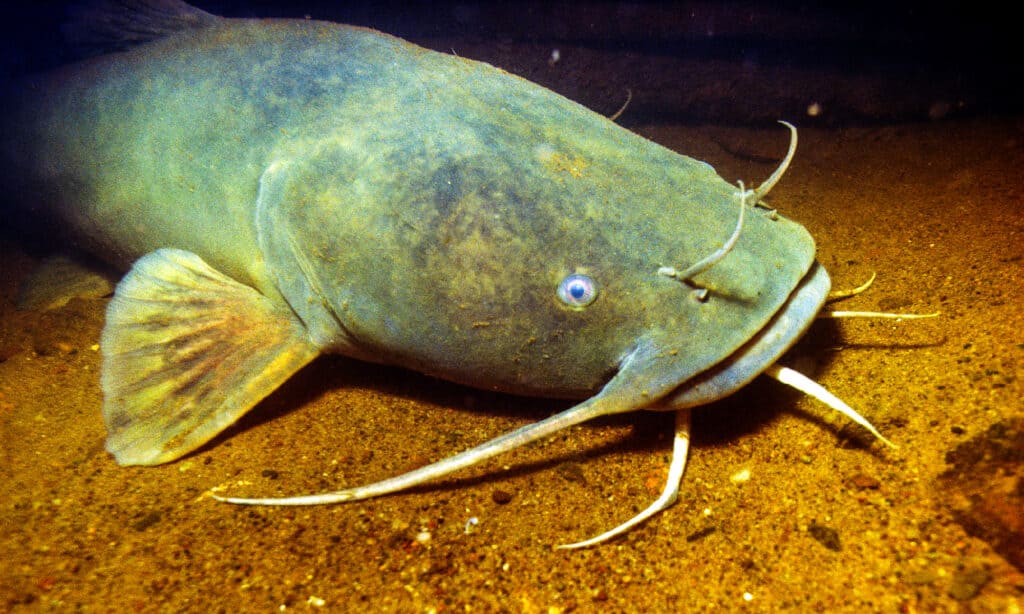
The largest flathead catfish caught in the Arkansas River weighed 80 pounds.
©iStock.com/stammphoto
2. Alligator Gar
When you come across the name alligator gar for the first time, you may wrongly assume that this fish species bears relations with alligators. However, that’s not the case. This gigantic fish got its name from its razor-sharp teeth and broad crocodilian head.
The alligator gar holds the distinction of being one of the largest freshwater fish found in North America and the largest member of the gar family. An adult alligator gar can weigh as much as 300 pounds. These fish are equally long, with some fully grown ones getting up to 9 feet long — almost twice the size of your average adult human.
Some of the distinguishing characteristics of the alligator gar include:
- Long, slender, cylindrical bodies
- Rounded tail fin
- Anal and dorsal fins situated back on the body
- Anal and dorsal fins opposite each other
- Diamond-shaped interlocking scales
- Long snouts with sharp teeth
- Toxic eggs to protect against predators.
While the largest alligator gar caught in Arkansas weighed 20 pounds, the biggest one caught in Arkansas River was less heavy. It weighed around 215 pounds.
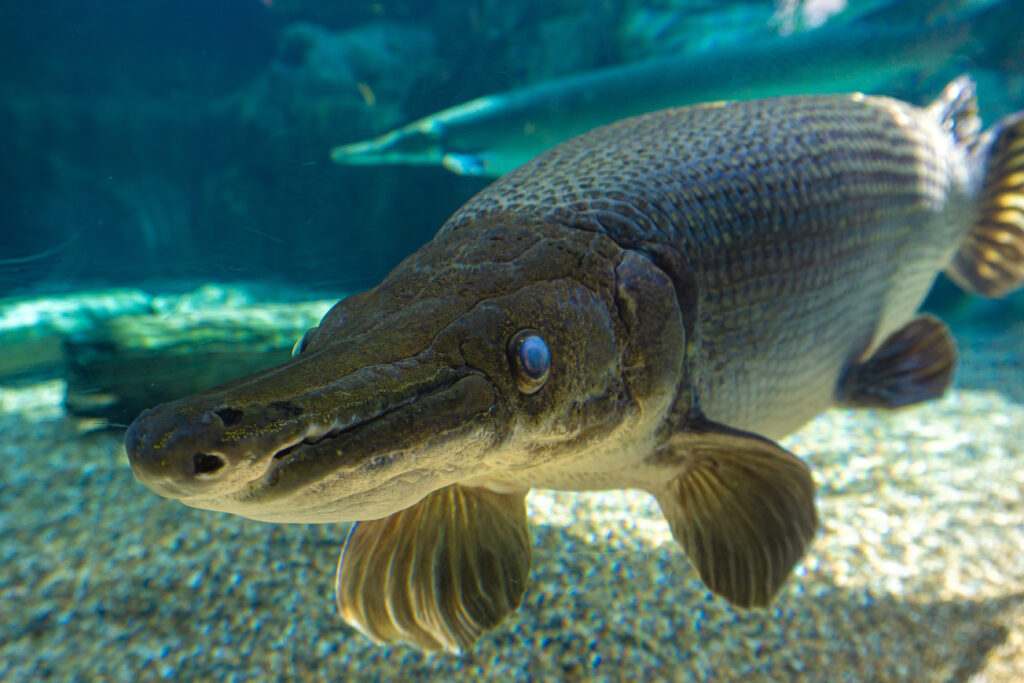
An adult alligator gar can weigh up to 300 pounds.
©TKBackyard/Shutterstock.com
3. Sauger
Another iconic fish that swims in the waters of the Arkansas River is the sauger. This fish species belongs to the perch family. The sauger is typically an elongated, cylindrical fish with large canine teeth. These fish species usually prefer larger rivers, where they spend most of their life.
Some of the attributes unique to a sauger fish include:
- Dark backs with dark spots
- A forked tail that has a peal streak on the bottom edge
- Spotted dorsal fin
- Black dots at the base of the pectoral fins.
These features can help you differentiate between sauger and walleye, especially since these two types of fish share a close resemblance. Another feature that may help you distinguish them is that saugers are slightly smaller than walleye.
And while saugers aren’t the largest fish, they are considerably sizable. At present, the record for the heaviest sauger in the world stands at 8 pounds and 12 ounces.
The largest sauger ever caught in the Arkansas River weighed 6 pounds and 12 ounces. Claud Eubanks achieved this feat in December 1976.

Saugers are elongated, cylindrical fish that belong to the perch family.
4. Longnose Gar
The longnose gar is another fish species of the gar family that swims in the waters of the Arkansas River. Like the alligator gar, the longnose gar has a long, slender cylindrical body. However, unlike the alligator gar, its head and teeth don’t resemble those of an alligator. They also have relatively shorter bodies.
Some of the unique features of this fish species include:
- A body that varies in color from dark olive to brown, with a whitish or pale silvery belly
- Dark spots on the back
- Beak-like snout with razor-sharp teeth
- The width of the eye diameter is more than the snout of the nostrils
- The fins are light grey.
According to the International Game Fish Association, the largest longnose gar ever caught weighed 43 pounds — as big as a refrigerator. Even so, most of them weigh 20-40 pounds and are roughly 3-5 feet long (most of their weight is on their nose region).
If you’re thinking of taking your boat out fishing for a longnose gar in the Arkansas River, know that you’ll not only need luck, but it will also take some doing to capture this big fish.
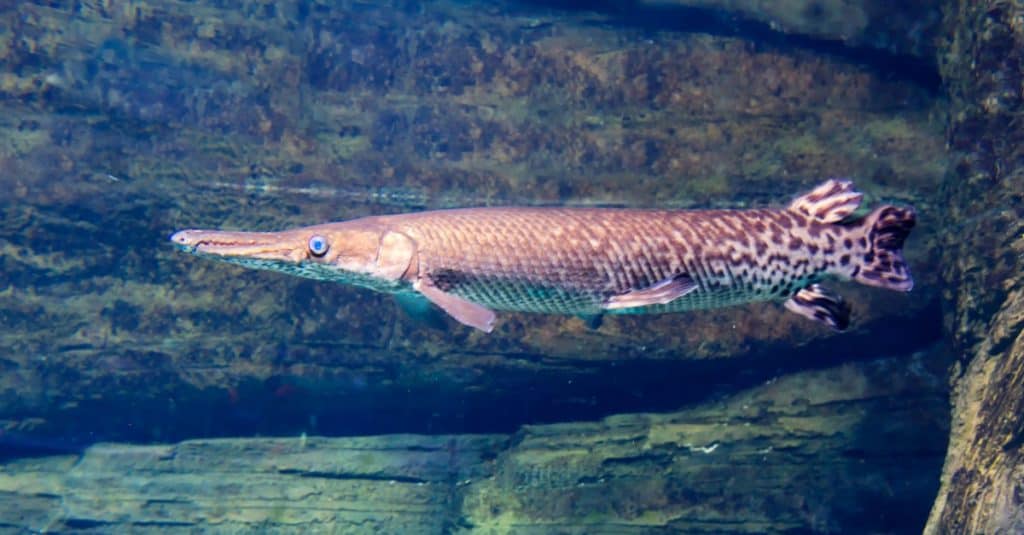
The largest longnose gar ever caught weighed 43 pounds.
©Galina Savina/Shutterstock.com
5. Striped Bass
Also known as the stripper or rockfish, the striped bass is the most prominent member of the sea bass family. This predatory fish prefers living in freshwater; it’s no wonder they thrive in the Arkansas River. Striped basses are white on the belly, silvery to olive green on the back, and often have 7-8 long stripes on either side of their body.
Other features unique to striped bass include:
- Two distinct tooth patches at the back of their tongue
- Two sharp points on each gill cover
- White belly
- Three spines on the anal fin
- Forked tail fin
- A deep notch on the dorsal fin
- Several spines on the first part of the dorsal fin.
Officially, the most prominent striped fin weighed around 81 pounds and 14 ounces. However, on average this fish species weighs 10 to 30 pounds and is 2 to 3 feet long.
You can catch stripers, including the striped bass, along the entire length of the Arkansas River, right from its mouth up to where it enters the Mississippi. The best time to fish is in spring when they migrate upriver into the tailwaters of the river dams.
No record-worthy catches of striped bass in the Arkansas River are current. So you stand a chance of being the first person to achieve that feat.
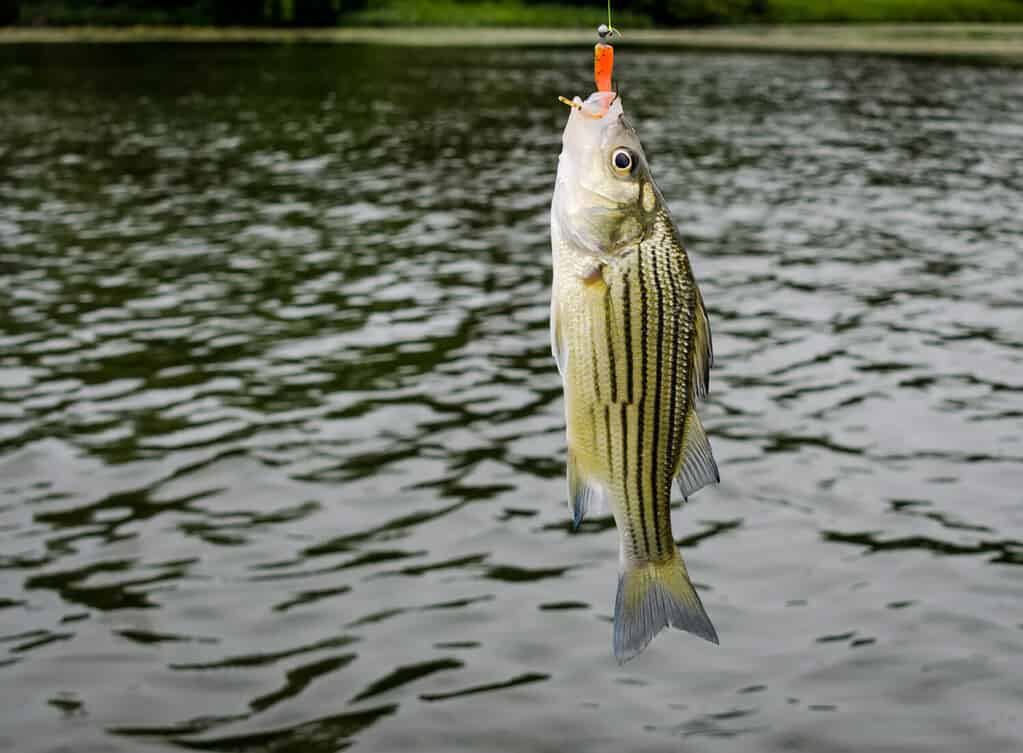
Anglers can catch striped bass along the entire length of the river up to where it enters the Mississippi River.
©HildeAnna/Shutterstock.com
6. Blue Catfish
If you thought the flathead catfish was the largest, you’re in for a surprise. Charles Ashley Junior caught a blue catfish weighing 116 pounds and 12 inches in the Mississippi on August 3, 2001. At present, this is the largest catfish ever caught. More recently in 2009, Dakota Hinson caught another sizable blue catfish weighing 95 pounds in the Mississippi River.
The blue catfish is the largest in North America, making it a true giant of the water. An adult blue catfish can weigh over 100 pounds and reach 5 feet long. In North America, these fish are primarily present in the Mississippi River and the Louisiana drainage, including the Arkansas River.
Given the proximity between the Arkansas River and the Mississippi River, where the two largest blue catfish were caught, it’s safe to say equally more significant blue catfishes swim the Arkansas River.
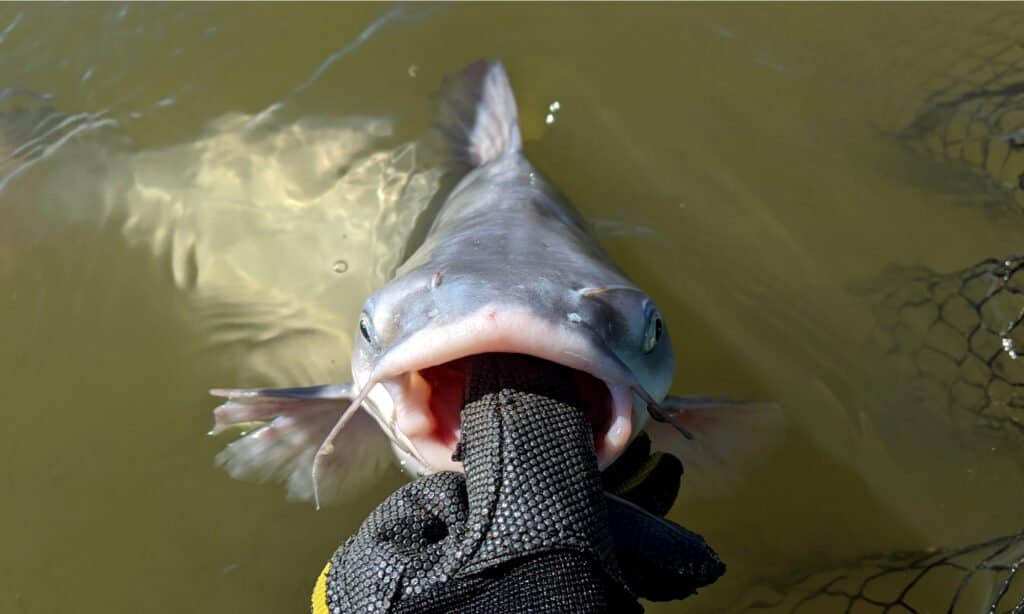
In North America, the blue catfish can be primarily found in the Mississippi River and the Louisiana drainage.
©M Huston/Shutterstock.com
7. Paddlefish
Another fish species found in the Arkansas River waters is the paddlefish. This species is often referred to as being primitive, given that they belong to one of the earliest diverging lineages of ray-finned fish. Paddlefish are almost exclusively North American, primarily found in the Mississippi River.
Some features common to all paddlefish include:
- Grey shark-like body
- Forked tail fin
- Long blade-like snout that is almost a third of its whole body
- No teeth
- No scales
- Tiny eyes.
Paddlefish can grow up to 7 feet long and weigh as much as 200 pounds. Even so, most of them often weigh 10-15 pounds. Currently, the largest paddlefish ever caught weighed 149 pounds, a weight that is 19 pounds more than the previous record that was set in 1976. The largest paddlefish ever caught in Arkansas weighed 118 pounds and 9 ounces — certainly a big catch.
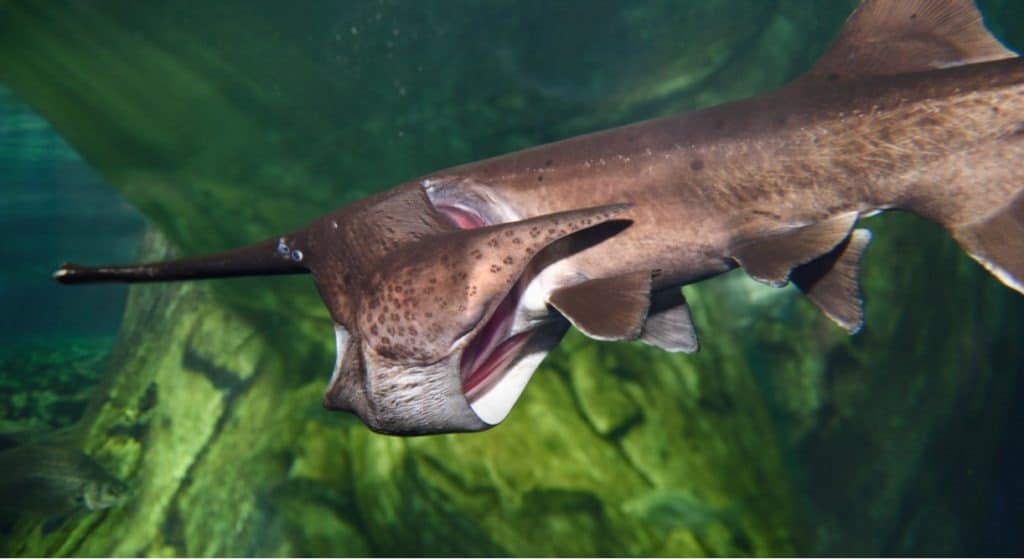
Paddlefish have a long blade-like snout and can grow up to 7 feet long.
©Reimar/Shutterstock.com
8. Brown Trout
The Arkansas River also has different types of trout, including brown trout. So if you are considering trout fishing, this river is an excellent place to start.
As the name suggests, the brown trout is brown. Their color often varies from silver brown to a more golden brown hue. Brown trout usually live in lakes, rivers, and streams.
Some of the unique characteristics of this fish species include the following:
- Tan and yellow sides
- Orange and red spots on the sides
- Slender body
- Long narrow head
- Typically spotted head and tail
- The mouth extends below the eyes
- Large to moderate mouth.
While not among the largest fish, brown trout can grow considerably. They can average around 33 pounds in weight and measure 16-31 inches.
The biggest brown trout ever caught in the Arkansas region weighed 40 pounds and 4 ounces. It was reeled in on the Little Red River by Howard Collins on May 9, 1992.
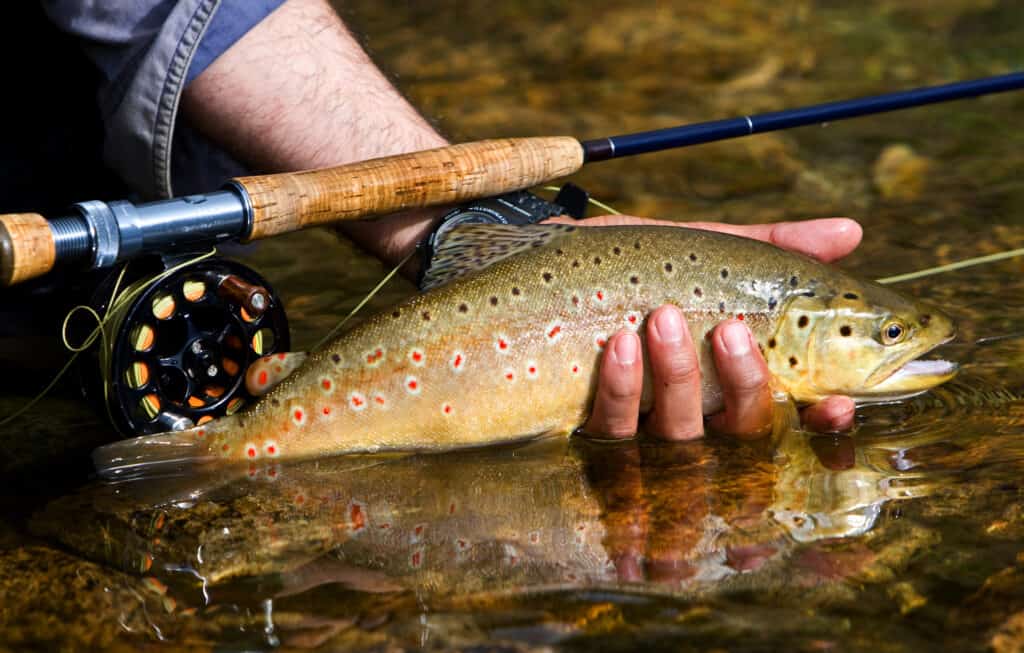
Brown trout usually live in lakes, rivers, and streams.
©iStock.com/MarceloDufflocqw
9. River Carpsucker
The river carpsucker is another freshwater fish present in the Arkansas River. Also known as silver carp, white carp, and quillback, this fish species is a bottom feeder that consumes and filters nutrients from detritus and silt, feeding on various organisms, including chironomids, alae, protozoans, and different planktonic animals and plants. River carpsuckers usually occupy the backwaters of rivers, reservoirs, and pools.
Here are some unique attributes of the river carpsuckers:
- Slightly curved back
- Compressed stout
- Prominent lower lips that project at the midpoint
- Large scales that cover their whole body
- Eighteen distinct caudal rays
- Silvery, deep, and usually thick body
- Sickle-shaped dorsal fin
- Whitish tail fin.
These attributes can help you identify this fish species easily while on your fishing adventures.
A river carpsucker usually weighs about 10 pounds and can grow up to 16-24 inches.
The largest carpsucker ever caught in the Arkansas River weighed 3 pounds and 2 ounces. Jimmy Ruple reeled it in using a rod and a reel on June 19, 2017. And while this catch seems a little small, considering the average size of these fish and the other types of fish mentioned in this post, it’s still a sizable catch.
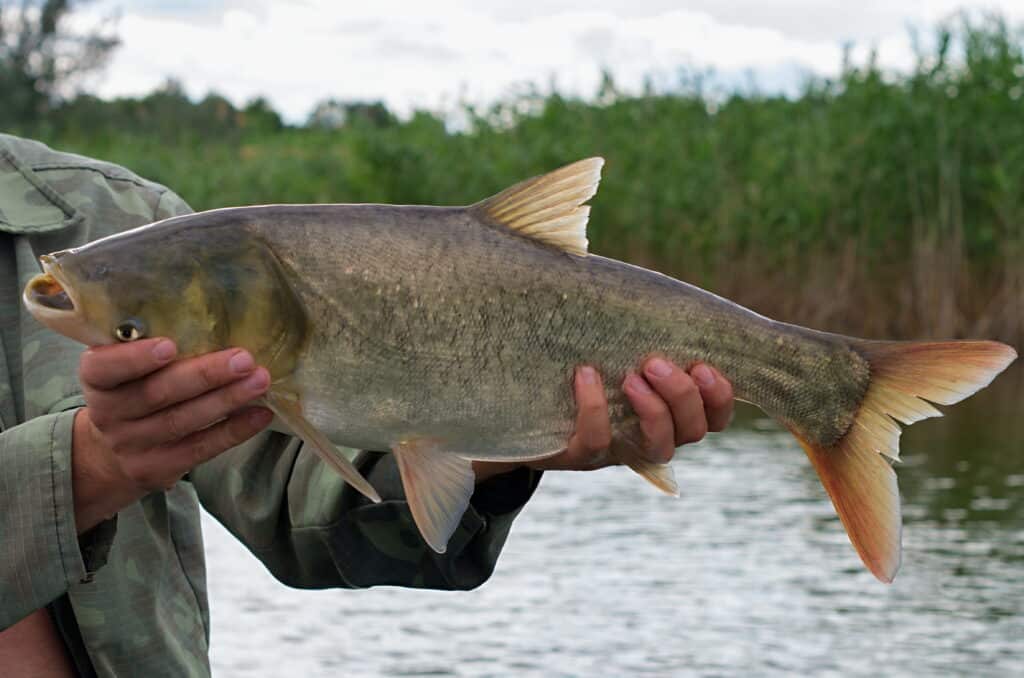
The river carpsucker is a bottom feeder that consumes and filters nutrients from silt and detritus.
©Balakleypb/Shutterstock.com
10. Shovelnose Sturgeon
The shovelnose sturgeon is the tiniest freshwater sturgeon native to North America. Also known as the sand sturgeon, switch tail, or hackleback, this fish species is the most abundant sturgeon in the Mississippi River.
Some features that are unique to this fish include:
- Flat, shovel-shaped snout
- Long tail base
- Long upper lobe on the tail fin
- The nostril closest to their eye is bigger than their eye
- Fringed barbels
- Lower lip with four lobes
- Elongated body
- No spiracle.
While big, the shovelnose sturgeon is not the largest sturgeon species, let alone the biggest fish. On average, an adult shovelnose sturgeon weighs 1.5 pounds and is about 21 inches long.
The largest shovelnose sturgeon caught in the Arkansas River weighed 1 pound and 10 ounces.
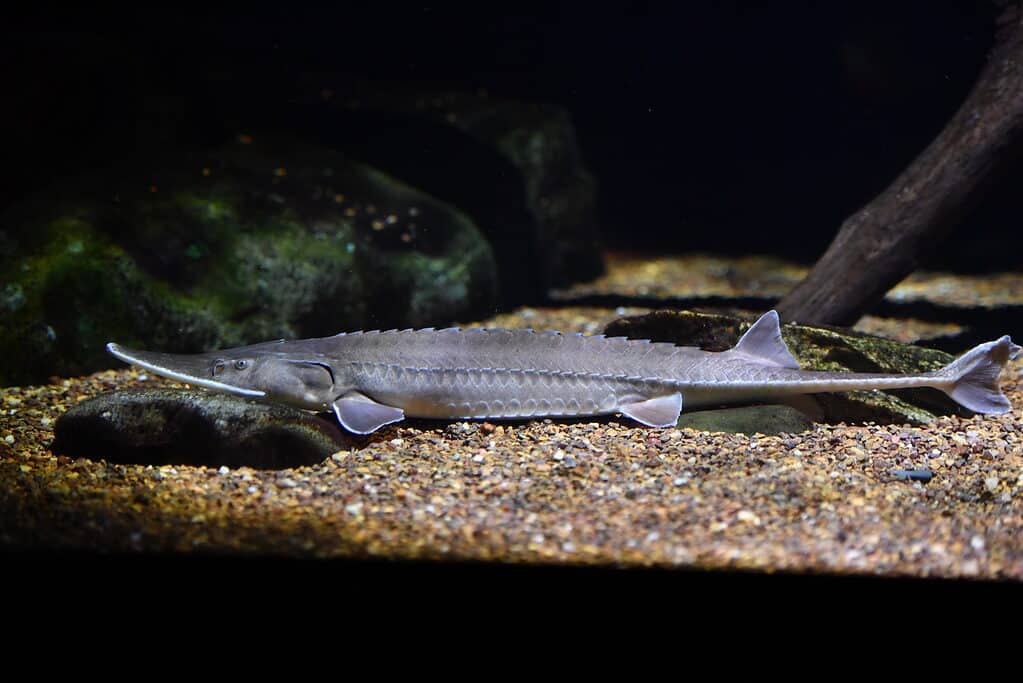
The shovelnose sturgeon is the most abundant sturgeon species in the Mississippi River.
©Andrea Izzotti/Shutterstock.com
11. Goldeye
Also known by other names, including shad money, Winnipeg goldeye and yellow herring, goldeye is part of the Hiodontidae family. The goldeye is a freshwater fish predominantly found in North American water bodies, including the Arkansas River. This fish species often prey on crustaceans, smaller fish, and insect larvae.
Some of the distinctive physical attributes of the goldeye fish include the following:
- Large gold eyes
- Compressed bodies
- Blunt snouts
- Dorsal fin opposite or behind the anal fin
- Two abdominal and pelvic fins
- Spineless cycloid scales
- A fleshy keel that extends from the pectoral fin to the base of the anal fin
- A sensory system known as the lateral line system.
The average length of a goldeye is approximately 15 to 17 inches. However, some grow to 20 inches. On the other hand, they typically weigh 1-2 pounds.
The largest goldeye ever caught globally weighs about 3 pounds and 13 ounces. However, the biggest goldeye caught in the Arkansas River weighed 2 pounds and 8 ounces. Some of the largest goldeyes swim the Arkansas River.
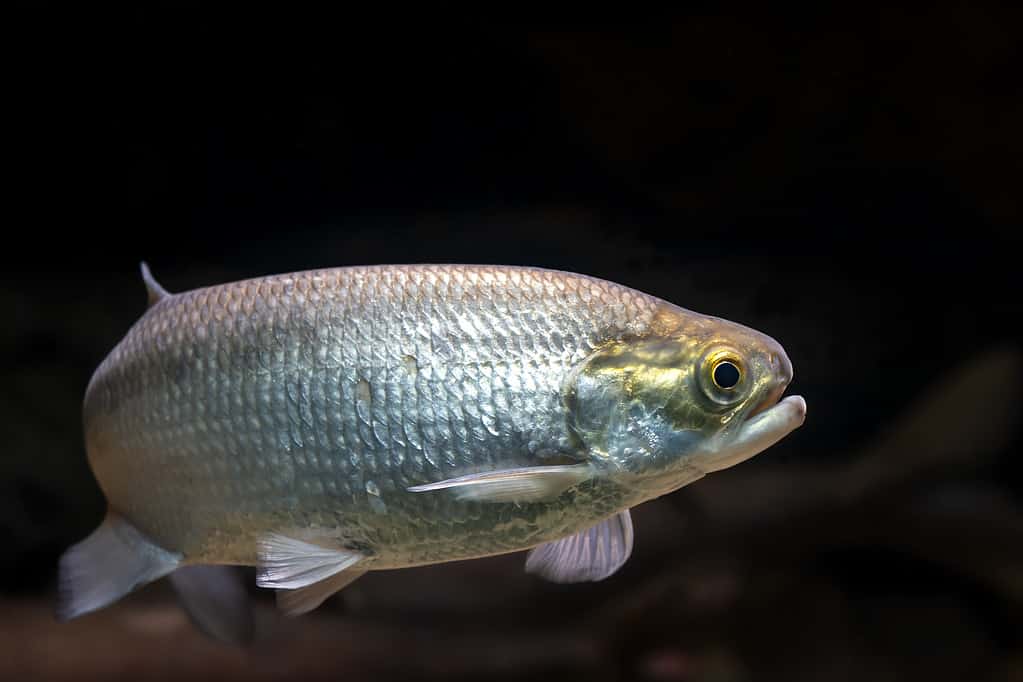
The goldeye is a freshwater fish mainly found in North America, including in the Arkansas River.
Unforgettable Fishing Experiences Await at Arkansas River
Fishing can be challenging, especially if you are engaging in it for the first time. This endeavor becomes even harder when you need to know the type of fish you are hoping to catch.
With more than 100 species of fish, big and small, determining which one to catch can be difficult. This guide has outlined some of the biggest fish in the Arkansas River that fishermen hoping for a record-breaking fish size can expect to find in this river.
In conclusion, fishing on the Arkansas River is an outstanding experience. With its beautiful scenery and plentiful and easy-to-catch fish, the atmosphere is an angler’s dream come true. Thanks to its vast diversity of aquatic life, this river — from its headwaters to its delta — is a haven for anglers. So, grab your rod and tackle, throw on your waders, and prepare for an unforgettable day of fishing in the Arkansas River. Happy fishing!
The photo featured at the top of this post is © JUN DONG/iStock via Getty Images
Thank you for reading! Have some feedback for us? Contact the AZ Animals editorial team.







